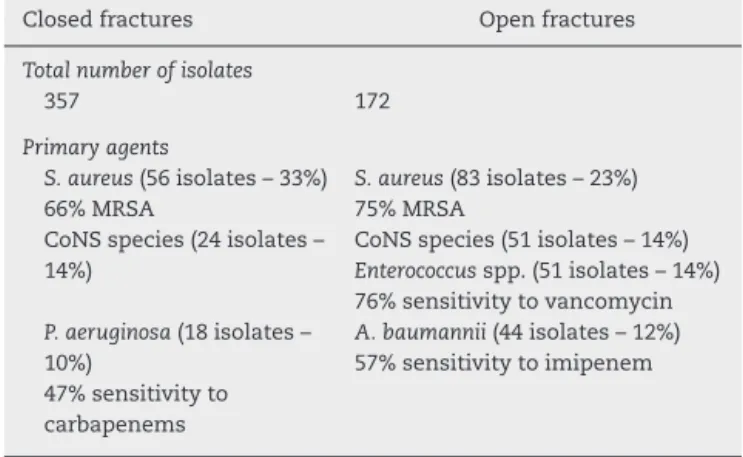rev bras ortop.2016;51(4):396–399
SOCIEDADE BRASILEIRA DE ORTOPEDIA E TRAUMATOLOGIA
w w w . r b o . o r g . b r
Original
Article
The
incidence
and
microbiological
profile
of
surgical
site
infections
following
internal
fixation
of
closed
and
open
fractures
夽
Priscila
Rosalba
Oliveira
∗,
Vladimir
Cordeiro
Carvalho,
Cassia
da
Silva
Felix,
Adriana
Pereira
de
Paula,
Jorge
Santos-Silva,
Ana
Lucia
Lei
Munhoz
Lima
UniversidadedeSãoPaulo,HospitaldasClínicas,InstitutodeOrtopediaeTraumatologia,SãoPaulo,SP,Brazil
a
r
t
i
c
l
e
i
n
f
o
Articlehistory:
Received21August2015 Accepted9September2015 Availableonline2February2016
Keywords:
Surgicalwoundinfection Internalfracturefixation Openfractures
Closedfractures
a
b
s
t
r
a
c
t
Objective:Toevaluatetheincidenceandmicrobiologicalprofileofsurgicalsiteinfections (SSIs)associatedwithinternalfixationoffracturesandtocomparedifferencesintheSSIs observedamongpatientswithclosedandopenfractures.
Methods:Retrospectivestudy.Analyzeddataincludedinformationfromallpatientswho underwentsurgeryforfixationofclosedoropenfracturesfromJanuary2005toDecember 2012andremainedoutpatientsforatleastoneyearfollowingsurgery.Incidenceofsurgical siteinfection(SSI)wascomparedbetweenpatientswithclosedandopeninfection,aswell aspolymicrobialinfectionandinfectionrelatedtoGram-negativebacilli(GNB).Cumulative antibiogramswereperformedtodescribemicrobiologicalprofiles.
Results:OverallincidenceofSSIwas6%.Thisincidencewassignificantlyhigheramong patientswith openfractures (14.7%) thanamongpatients withclosedfractures (4.2%). TheproportionsofpatientswithpolymicrobialinfectionsandinfectionsduetoGNBwere alsosignificantly higheramongpatients withopen fractures. Staphylococcusaureus and coagulase-negativeStaphylococcus(CoNS)speciesweretheprimaryinfectiousagents iso-latedfrombothgroups.TheoverallincidenceofMRSA(methicillin-resistantS.aureus)was 72%.A.baumanniiwasthepredominantGNBisolaterecoveredfrompatientswithopen frac-turesandP.aeruginosawasthemostfrequentisolaterecoveredfrompatientswithclosed fractures,bothexhibitedlowratesofsusceptibilitytocarbapenems.
Conclusions:IncidenceofSSIsrelatedtotheinternalfixationoffractureswassignificantly higheramongpatientswithopenfractures,indicatingthatanopenfracturecanbearisk factorforinfection.Amongthebacterialisolates,S.aureus(withahighprevalenceofMRSA) andCoNSspeciesweremostprevalent.A.baumanniiandP.aeruginosaisolatesunderscored thelowrateofsusceptibilitytocarbapenemsthatwasobservedinthepresentstudy.
©2016SociedadeBrasileiradeOrtopediaeTraumatologia.PublishedbyElsevierEditora Ltda.ThisisanopenaccessarticleundertheCCBY-NC-NDlicense(http:// creativecommons.org/licenses/by-nc-nd/4.0/).
夽
WorkdevelopedattheUniversidadedeSãoPaulo,HospitaldasClínicas,InstitutodeOrtopediaeTraumatologia,SãoPaulo,SP,Brazil. ∗ Correspondingauthor.
E-mail:priscila.rosalba@hc.fm.usp.br(P.R.Oliveira).
http://dx.doi.org/10.1016/j.rboe.2015.09.012
rev bras ortop.2016;51(4):396–399
397
Infecc¸ão
de
sítio
cirúrgico
após
fixac¸ão
de
fraturas
fechadas
e
expostas
–
Incidência
e
perfil
microbiológico
Palavras-chave:
Infecc¸ãodaferidaoperatória Fixac¸ãointernadefraturas Fraturasexpostas Fraturasfechadas
r
e
s
u
m
o
Objetivo:AvaliaraincidênciaeoperfilmicrobiológicodasISCrelacionadasaprocedimentos defixac¸ãodefraturasnumhospitalacadêmicoortopédicoterciárioemSãoPaulo,Brasil,e compararasdiferenc¸asobservadasentreospacientescomfraturasfechadaseexpostas. Métodos: Estudoretrospectivo.Foramincluídosnaanáliseosdadosrelativosatodosos pacientesquepassaramporprocedimentocirúrgicoparafixac¸ãodefraturasfechadasou expostasdejaneirode2005adezembrode2012equemantiveramseguimentoporpelo menosumano.Foiverificadaapresenc¸adeassociac¸ãoentreotipodefratura,aincidência deISCeasincidênciasdeinfecc¸õespolimicrobianaseporbacilosGram-negativos.Operfil microbiológicofoiestabelecidopormeiodaelaborac¸ãodeantibiogramascumulativos. Resultados: Aincidênciageraldeinfecc¸ãode6%.Essaincidênciafoimaiornogrupode pacientescomfraturasexpostas(14,7%)doquenaquelescomfraturasfechadas(4,2%),com diferenc¸aestatisticamentesignificante.Onúmerodepacientescominfecc¸ões polimicro-bianasecominfecc¸õesrelacionadasaBGNtambémfoisignificativamentemaiornogrupo decasosrelacionadosafraturasexpostas.StaphylococcusaureuseespéciesdeStaphylococcus coagulase-negativo(CoNS)foramosprincipaisagentesisoladosnosdoisgrupos.A incidên-ciadeMRSA(S.aureusresistenteameticilina)dentretodososisoladosdeS.aureusfoide 72%.A.baumanniifoioprincipalBGNisoladoentreospacientescomfraturasexpostase P.aeruginosaentreospacientescomfraturasfechadas.Emambososcasos,observaram-se baixosíndicesdesensibilidadeacarbapenêmicos.
Conclusões: AincidênciadeISCrelacionadaàfixac¸ãointernadefraturasfoi significante-mentemaiornospacientescomfraturasexpostas,oqueindicaqueessetipodefraturapode serumfatorderiscoparaaocorrênciadessetipodeinfecc¸ão.Dentreosisoladosbacterianos, predominaramnogeralS.aureus(comelevadaprevalênciadeMRSA)eS.coagulase-negativo. DentreosBGN,houvepredomíniodeA.baumannitambémentreosisoladosdepacientes comfraturasexpostaseP.aeruginosaentreosisoladosdaquelescomfraturasfechadas.
©2016SociedadeBrasileiradeOrtopediaeTraumatologia.PublicadoporElsevier EditoraLtda.Este ´eumartigoOpenAccesssobumalicenc¸aCCBY-NC-ND(http:// creativecommons.org/licenses/by-nc-nd/4.0/).
Introduction
Surgicalsiteinfections(SSIs)associatedwithinternalfixation offracturesareregardedasseriouscomplications.AnSSI con-stitutesachallengefortheentirestaffinvolvedinpatient’s carebecauseitsignificantlyincreasesrecoverytimeand treat-ment costs and negatively impacts bothfunctional results andlong-termrehabilitation.1,2AlthoughincidenceofSSIsis expectedtobehigherinpatientswithopenfracturesthanin patientswithclosedfractures,fewstudieshaveconfirmedthis hypothesis.3,4 RegardingthemicrobiologicalprofilesofSSIs, Gram-negativebacilli(GNB),mostnotablyAcinetobacter bau-mannii andPseudomonas aeruginosa,have been described as havingincreasinglyimportantrolesintheseinfections, par-ticularlyincasesinvolvinghigh-energytrauma.5–8
Thecurrentstudy soughtto evaluatethe incidenceand microbiologicalprofileofSSIsassociatedwithinternalfixation offracturesandtocomparedifferencesintheSSIsobserved amongpatientswithclosedandopenfractures.
Methods
AretrospectivestudywasconductedattheInstitutode Ortope-diaeTraumatologia,atertiaryorthopedicacademichospitalin
SãoPaulo,Brazil.Analyzeddataincludedinformationfromall patientswhounderwentsurgeryforfixationofclosedoropen fracturesfromJanuary2005toDecember2012andremained outpatientsforatleastoneyearfollowingsurgery.Thesedata werecollectedfromthedatabasemaintainedbythe institu-tion’sInfectionControlBoard.
Inaccordancewiththeinstitution’sprotocol,patientswith closedfractureswhounderwentsurgeryfortheinternal fix-ationoftheirfracturesreceived24hofantimicrobial prophy-laxiswithcefazolin.PatientswithtypeIopenfractures accord-ingtotheGustiloclassificationreceivedantimicrobialtherapy with cefazolin for 14 days, beginning at their admission. PatientswithopenfracturesofGustilotypesIIandIIIreceived combinationtherapywithclindamycinandgentamicinfor14 days,beginningatadmission.Inaddition,patientswithopen fractures initially had their fractures stabilized byexternal fixation;internalfixationwassubsequentlyperformedafter improvementinthesofttissueadjacenttofracture.
398
rev bras ortop.2016;51(4):396–399Table1–Patientpopulationofthestudy.
Total Closedfractures Openfractures Comparisonbetweenthegroups withclosedandopenfractures
Patients 11,030 9143 1887 –
PatientswithSSIs 664(6%) 386(4.2%) 278(14.7%) p<0.001 Patientswithpolymicrobialinfections 199(1.8%) 90(1%) 109(5.8%) p<0.001 PatientswithGNBinfections 293(2.65%) 130(1.42%) 163(8.64%) p<0.001
LaboratoryStandardInstitute(CLSI)standards.10Onlyisolates fromculturesofbone,deepsofttissueorexudatecollected intheoperating roomafterthe debridement ofdevitalized tissueswereconsidered.
Chi-squaretestswereusedtodeterminehowfracturetype wasassociatedwiththeincidencesofSSI,polymicrobial infec-tionsandGNBinfections.Theseassociationswereestimated by utilizing bivariate logistic regressions to calculate odds ratios(ORs)andthecorresponding95%confidenceintervals. Microbiological findings were only assessed by descriptive analysis.
Results
Duringtheanalyzedperiod,11,030patientsunderwent inter-nalfixationoffractures,including9143patients(82.9%)with closedfracturesand1887patients(17.1%)withopenfractures. Atotalof664patientspresentedwithSSIsrelatedtofixation procedures;thus,theoverallincidenceofinfection was6%. Thisincidencewassignificantlyhigheramongpatientswith openfractures(14.7%)thanamongpatientswithclosed frac-tures(4.2%). Theproportionsofpatientswithpolymicrobial infectionsandinfectionsduetoGNBwerealsosignificantly higheramongpatientswithopenfractures(Table1).
Themicrobiologicalfindingsindicatedthatatotalof529 infection-associatedbacterialisolateswererecovered, includ-ing 357isolatesfrom patientswithopen fractures and 172 isolatesfrompatientswithclosedfractures.Inbothgroups, the predominant isolates were Gram-positive cocci, which accountedfor53%oftheobservedinfections.GNBaccounted for45%oftheisolates;bothpatientgroupsexhibitedasimilar incidenceofGNB,althoughagreaterabsolutenumberof iso-lateswererecoveredfrompatientswithopenfracturesthan frompatientswithclosedfractures.
Staphylococcusaureusandcoagulase-negativeStaphylococcus (CoNS) specieswere the primaryinfectious agentsisolated frombothgroups.TheoverallincidenceofMRSA (methicillin-resistantS.aureus)was72%;thisincidencewas75%among patientswithopenfractures and66% amongpatients with closedfractures.Forthegroupofpatientswithopenfractures, inadditiontoCoNSspecies,Enterococcusspp.werethesecond mostagentthatwasisolated;76%oftheEnterococcusisolates exhibitedsusceptibilitytovancomycin.
A.baumanniiwasthepredominantGNBisolaterecovered frompatientswithopenfractures.P.aeruginosawasthemost frequentisolaterecoveredfrompatientswithclosedfractures. Both A. baumanniiand P. aeruginosa exhibited low rates of susceptibilitytocarbapenems(susceptibilities toimipenem of57%and47%,respectively).Anaerobic bacteriaandfungi
Table2–Comparisonofthemainmicrobiological findingsinthegroupsofpatientswithclosedandopen fractures.
Closedfractures Openfractures
Totalnumberofisolates
357 172
Primaryagents
S.aureus(56isolates–33%) 66%MRSA
S.aureus(83isolates–23%) 75%MRSA
CoNSspecies(24isolates– 14%)
CoNSspecies(51isolates–14%)
Enterococcusspp.(51isolates–14%) 76%sensitivitytovancomycin
P.aeruginosa(18isolates– 10%)
47%sensitivityto carbapenems
A.baumannii(44isolates–12%) 57%sensitivitytoimipenem
accounted for2% of the isolates. Table 2 summarizes the microbiologicalfindingsdescribedinthisstudy.
Discussion
The incidence of SSI was significantly higher in patients withopenfractures.Althoughthisfindingistobeexpected duetothe highdegreeofcontaminationobservedinthese high-energyinjuries,2fewstudieshaveproventhehigher inci-denceofSSIinthispopulation,and noneofthem featured asampleaslargeasthatofthepresentstudy.Therewasa predominanceofGNBinfectionsandpolymicrobialinfections inthegroupofpatientswithopenfractures.Otherstudies, conducted mainlyinsoldiers stationedin theMiddle East, corroboratethesefindings.1,5–7
rev bras ortop.2016;51(4):396–399
399
Conclusion
TheincidenceofSSIsrelatedtotheinternalfixationof frac-tures was significantly higher among patients with open fractures,indicatingthatanopenfracturecanbearisk fac-torforinfection.Thecurrentstudyalsoindicatedthatthere were a significantly elevated number of polymicrobialand GNBinfectionsamongpatientswithprioropenfractures. Fur-therstudiesare neededtoevaluatepotentialvariablesthat couldberelevanttothesefindings.
Amongthebacterialisolates,S.aureus(withahigh preva-lence of MRSA) and CoNS species were most prevalent. Enterococcusspp.(withalowrateofsensitivitytovancomycin) and A. baumannii were also prevalent among the isolates recoveredfrompatientswithopen fractures.Inaddition, P. aeruginosawasoneofthemoresignificantisolatesrecovered frompatientswithclosedfractures.TheA.baumanniiandP. aeruginosaisolatesunderscoredthelowrateofsusceptibility tocarbapenemsthatwasobservedinthepresentstudy.
Conflicts
of
interest
Theauthorsdeclarenoconflictsofinterest.
Acknowledgments
WethankAmericanJornalExpertsforeditorialandwriting assistance.
r
e
f
e
r
e
n
c
e
s
1. TorbertJT,JoshiM,MoraffA,MatuszewskiPE,HolmesA, PollakAN,etal.Currentbacterialspeciationandantibiotic
resistanceindeepinfectionsafteroperativefixationof fractures.JOrthopTrauma.2015;29(1):7–17.
2.HanniganGD,PulosN,GriceEA,MehtaS.Currentconcepts andongoingresearchinthepreventionandtreatmentof openfractureinfections.AdvWoundCare(NewRochelle). 2015;4(1):59–74.
3.GaeblerC,BergerU,SchandelmaierP,GreitbauerM,
SchauweckerHH,ApplegateB,etal.Ratesandoddsratiosfor complicationsinclosedandopentibialfracturestreatedwith unreamed,smalldiametertibialnails:amulticenteranalysis of467cases.JOrthopTrauma.2001;15(6):415–23.
4.Court-BrownCM.Reamedintramedullarytibialnailing:an overviewandanalysisof1106cases.JOrthopTrauma. 2004;18(2):96–101.
5.BurnsTC,StinnerDJ,MackAW,PotterBK,BeerR,EckelTT, etal.Microbiologyandinjurycharacteristicsinsevereopen tibiafracturesfromcombat.JTraumaAcuteCareSurg. 2012;72(4):1062–7.
6.JohnsonEN,BurnsTC,HaydaRA,HospenthalDR,MurrayCK. InfectiouscomplicationsofopentypeIIItibialfractures amongcombatcasualties.ClinInfectDis.2007;45(4): 409–15.
7.ModyRM,ZaporM,HartzellJD,RobbenPM,WatermanP, Wood-MorrisR,etal.Infectiouscomplicationsofdamage controlorthopedicsinwartrauma.JTrauma.
2009;67(4):758–61.
8.GieseckeMT,SchwabeP,WichlasF,TrampuzA,KleberC. Impactofhighprevalenceofpseudomonasandpolymicrobial gram-negativeinfectionsinmajorsub-/totaltraumatic amputationsonempiricantimicrobialtherapy:a retrospectivestudy.WorldJEmergSurg.2014;9(1):55.
9.MaragakisLL,PerlTM.Basicsofsurgicalsiteinfection surveillanceandprevention.In:LautenbachE,WoeltjeKF, MalaniPN,editors.Practicalhealthcareepidemiology.3rded. Chicago,IL:TheUniversityofChicagoPress;2010.p.173–85.
